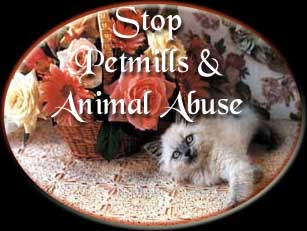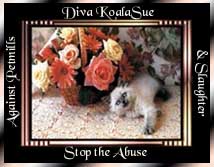
|
A puppy mill is a facility where dogs are bred indiscriminately for profit. Puppy mill operators want to minimize their expenses and maximize their profits. Female dogs are continuously bred from their first heat until their productivity drops or the popularity of the breed changes; then they are sold or killed. Many of these animals are bred despite illness, physical injuries and congenital deformities and receive little or no veterinary care. They are the victims of greed and cruelty. To stop puppy mills, you have to stop buying animals from pet stores and breeders who are over breeding thier animals to make more money. |
|
Courtesy of Kathleen Faulconer,
Sheltie E-mail list, 5/17/97 At the pet stores I worked in in
the '70s puppies were bought from puppy mills. Even then the
profit margin was pretty good for the pet stores so this was
the way to go financially. The pups were bought for around $75.00
and sold for up to $250.00. There were several lists to pick
puppies from. The owner of the store placed orders like any retailer.
So many of this breed, so many of that. Sometimes there were
specials, discounted because the pups were older than 6 weeks!Within
a certain amount of time the orders were filled. Filthy crates
that resembled fruit boxes would arrive at the door filled with
pups (as many as four if the breed was small) and covered with
airline stickers. Evidence that there were many plane changes
along the way from the midwest to California. I had the lovely
job of opening the boxes. I wasted no time in getting them open.
After some experience I knew that it was a matter of life and
death if I delayed. The boxes opened from the top and I could
rip them open and peek in. Picture this if you can: Each crate
would be soaked with filth. Urine and feces covering the crate
and the pups inside. Many were so covered with muck that you
could not recognize the breed. No water or food had been given
during the long trip. Many of the breeds we "bought"
were toy breeds. Fragile lives, easy sales. Without thinking,
after a while, I learned to set up a triage unit. I would open
all the boxes at once, first looking for dead puppies. IT was
not shocking to have 25-50% dead pups. Those I set aside, after
determining that there was no hope (rigor mortis was a good clue),
in a pile. Then I looked for the weak but still breathing ones.
These got first priority. I would be ready to pour honey down
their throats and try whatever I could to get them going again.
Remember this was a long time ago and we had no real revival
methods. I was usually successful at getting them on their feet.
People are amazed at the lives I can save now, well.... I had
a lot of practice. Happy, bouncy pups got taken care of next,
that included the removal of the encrusted feces and a quick
bath. It was disgusting, no two ways about it. After the initial
trauma of the puppies arrival, we could assess their condition.
Most of the puppies were infected in some area, ears, eyes, etc.
ALL the pups were filled with worms. I cannot forget the day
that an Irish setter pup died before my eyes, vomiting and diarrhea,
piles of round worms came out and nothing else. Followed by a
violent seizure. Then there was the schnauzer pup with docked
ears, kept unclean and allowed to infect, covered with black
gangrene. She was saved but her ears were not. They were cut
to the skull by the vet. We did not know what Parvo was either
but, judging by the number of pups that died within a few days,
we had it then......bigtime. |
links and read!!! It could mean the life of your
beloved Pet!!! Then help us do something about it!
These sites are very graphic and to the point.
They are NOT for CHILDREN!
POLLUTED PET FOOD - Commercial pet food
and stock feed contain a cocktail of dead
domestic animals and deadly environmental toxins.

Nexus: Pet Food
|
local authorities. |





